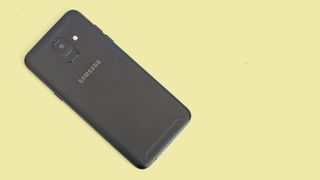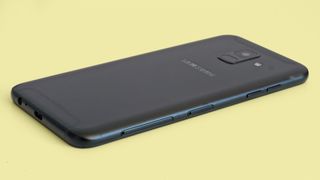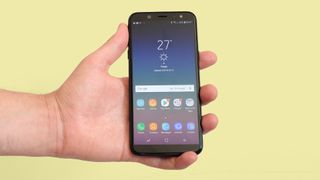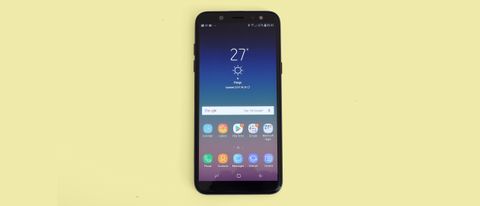TechRadar Verdict
The Samsung Galaxy A6 is a smart-looking phone with one too many dated elements, given the price. From its weak GPU to its low-resolution screen, there are better rivals.
Pros
- +
Smart aluminum casing
- +
Rich display colors
- +
Decent front-facing camera
Cons
- -
Weak GPU
- -
Low screen res reveals OLED fizz
- -
Lack of Auto HDR spoils the camera
Why you can trust TechRadar
The Samsung Galaxy A6 is a budget alternative to the Samsung Galaxy S9. It’s less powerful, a little less pretty, but also costs a third of the price.
For some, the combination of a desirable family name and smart design will be enough. However, that the Moto G6 Play and Honor 9 Lite get you more in almost every area for less money is hard to ignore.
Camera smarts and display definition are the two lacking areas here. A $368, £259 (roughly AU$500) phone without Auto HDR in 2018 is disappointing, and Samsung’s OLED screens highlight the limited screen resolution more than a cheaper LCD phone.
Key features
- 18.5:9 OLED screen with low 1480 x 720 resolution
- Lacks USB-C and camera features
- 16MP cameras on both front and back
Samsung makes several phones for people who can’t afford the Galaxy S9 family of mobiles. The Samsung Galaxy A8 simply takes away some of the flashy extras, without all that much of a day-to-day compromise.
The Samsung Galaxy A6 on the other hand has a few more obvious cuts, made in order to lower the price further. It uses an 18.5:9 OLED screen, but the resolution is just 1480 x 720 pixels, for example.
It does not have USB-C charging either, sticking with dated micro USB instead. And most camera additions are absent too, like optical image stabilization (OIS), advanced processing and Auto HDR.

The compromises here are similar to those seen in the Moto G6 Play, a significantly cheaper phone. However, the core camera hardware here is a little better. The Samsung Galaxy A6 has a 16MP f/1.7 lens rear camera and a 16MP f/1.9 one for selfies.
You can get the phone in 32GB and 64GB variants, but we’re looking at the 32GB version here.
Design
- Aluminum casing
- Slim and fairly light
- Rear fingerprint scanner
Build and design are Samsung Galaxy A6 high points. They are in other recent Galaxy A-series phones too.
However, this is not a glass mobile, the preferred style for not just Samsung but every phone-maker at the moment. Its back and sides are aluminum, with thin non-metallic loops on the back for the phone’s antennas.
These loops are visually important, and stop the Samsung Galaxy A6 from becoming an ultra-plain block of metal. Toughened 2.5D glass, which is ever-so-slightly curved at the edges, sits on the front. And there’s a thin band of plastic between the metal and glass to help avoid display fracturing should you drop the phone.

Is the Samsung Galaxy A6 exciting or dynamic? Not really. However, it’s a refreshing change from glass-obsessed phones, and is also slim and light.
7.7mm thick and 70.8mm wide, the Samsung Galaxy A6 is thinner and just slightly wider than a Galaxy S9. It’s easy to handle.
There’s also a fingerprint scanner on the Samsung Galaxy A6’s back, just below the camera lens. It’s slightly too high, not particularly recessed and not all that fast. But it is reliable and looks good, all-but merged with the camera.
USB-C is the one obvious missing feature. This charger shape is often associated with fast charging, but the reversible connector is the actual benefit. Micro USB can be annoying if you charge your phone by scrambling around under a bedside table at 11:30pm to find the cable.

Micro USB can support fast charging, but this phone does not. You get a standard adaptor in the box and we didn’t see a ‘fast charge’ pop-up when we tried a Samsung Adaptive fast charger either.
Any other compromises? The Samsung Galaxy A6’s side buttons are plastic rather than metal, and its SIM tray design is less clean than Samsung’s higher-end phones.
There’s a tray for your nanoSIM and a much larger one for the microSD, with a blocked-out spot for a second SIM. This suggests the phone may have a second SIM slot in other countries.
Screen
- 1480 x 720 OLED screen
- Rich color
- Slightly fuzzy display image
The Samsung Galaxy A6 has a 5.6-inch Super AMOLED screen with an 18.5:9 shape. More of the front is taken up by screen than in mid-range phones of 2016-2017.
Some parts of the screen are very strong, others fall behind standard at the price. The strong elements are those usually associated with OLED.
Contrast is excellent and color very punchy, if you want it to be. Like other Samsung phones, you can choose between color profiles that dramatically alter the look.
The Samsung Galaxy A6’s standard mode is ‘Adaptive Display’. A screen equivalent of an energy drink, it makes color look vibrant, increases tonal contrast and uses color temperature to maximize perceived brightness.

It’s the color strategy of most higher-end phones. But, crucially, Samsung keeps it under control, so your photos don’t appear more saturated than they are when you check them out in the gallery app. Samsung is a master of OLED phone screens.
Display purists should try the other color modes: Cinema, Photo and Basic. These roughly translate to the Adobe RGB (Photo), DCI-P3 (Cinema) and sRGB (Basic) standards. All three are great. Just pick the one that makes Android look best to your eyes.
Resolution is the main issue. Like several sub-£200/$200 Androids, the Samsung Galaxy A6 has a lower-than-Full-HD screen. It’s 1480 x 720 pixels. Recently we’ve commented that lower-resolution screens like this can still look very good, but the difference is more noticeable here.
First, we have to pay more in this case. At the price, just about every other manufacturer offers a 1080p resolution.

There’s also a particular problem with the Samsung Galaxy A6’s screen type. Samsung OLEDs use a pixel structure called PenTile, where pixels share sub pixels. LCD screens don’t share sub pixels.
As a result, the Samsung Galaxy A6’s screen looks a little fuzzy, particularly when displaying small fonts. You’ll get used to the day-to-day effects of this fairly quickly, but play a game like PUBG and small player names will be hard to read.
The Samsung Galaxy A6's screen is also not as bright as Samsung’s high-end phones, and doesn’t use any dynamic techniques to improve visibility on a bright day. That said, it’s no worse than any other phone at the price in this respect.
Andrew is a freelance journalist and has been writing and editing for some of the UK's top tech and lifestyle publications including TrustedReviews, Stuff, T3, TechRadar, Lifehacker and others.

